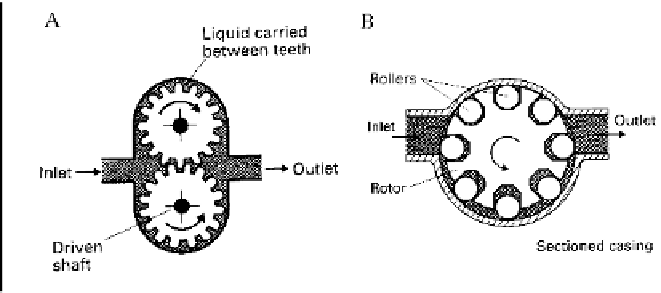Agriculture Reference
In-Depth Information
since all parts are metal. The case may be bronze with stainless steel impel-
lers, or it may be made entirely of bronze.
Figure 8.14A
illustrates the gear
pump.
Figure 8.14A and B
Figure A illustrates the gear pump and B the roller
pump.
c.
Diaphragm Pumps
Diaphragm pumps deliver low volume (3 to 10 gpm) at low to moderate
pressure (10 to 100 psi). They withstand abrasion from wettable powder mix-
tures much better than the gear or roller pumps because the spray mixture does
not contact any moving metal parts except the valves. Diaphragm pumps are
positive-displacement, self-priming pumps. The rubber or neoprene diaphragm
may be damaged by some solvents. The pump case is usually iron.
Figure
8.15A
digrams the internal structure of a dighragm pump.
d.
Centrifugal Pumps
Centrifugal pumps are relatively inexpensive pumps adaptable to a wide
variety of spray applications. Generally, they deliver high volume (up to 200
gpm) at low pressures (5 to 70 psi); however, two-stage pumps develop high
pressures (up to 200 psi). Used on agricultural sprayers, commercial spray-dip
machines, and other equipment, these are not positive-displacement pumps, so
pressure regulators and relief valves are not necessary. They are not
self-priming and must be mounted below the tank outlet or with a built-in
priming system. Centrifugal pumps are well adapted for spraying abrasive
materials because the impeller does not contact the pump housing. Slany
models are easily repairable. The pump case is usually iron; the impeller is




